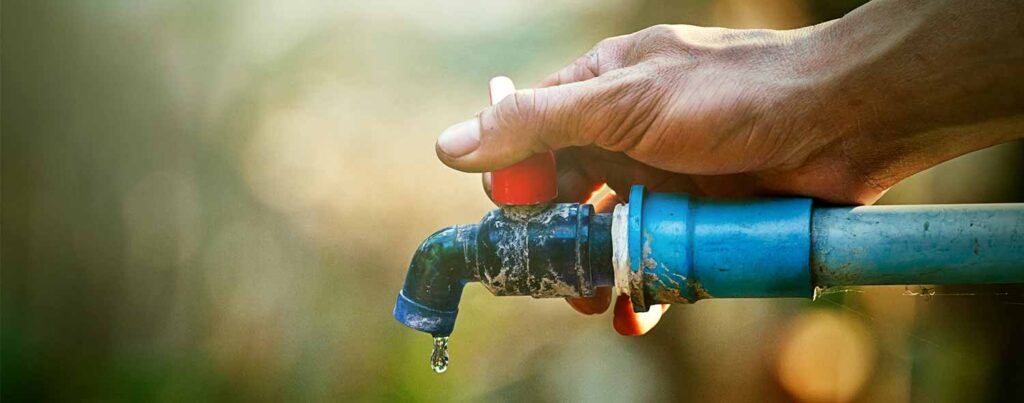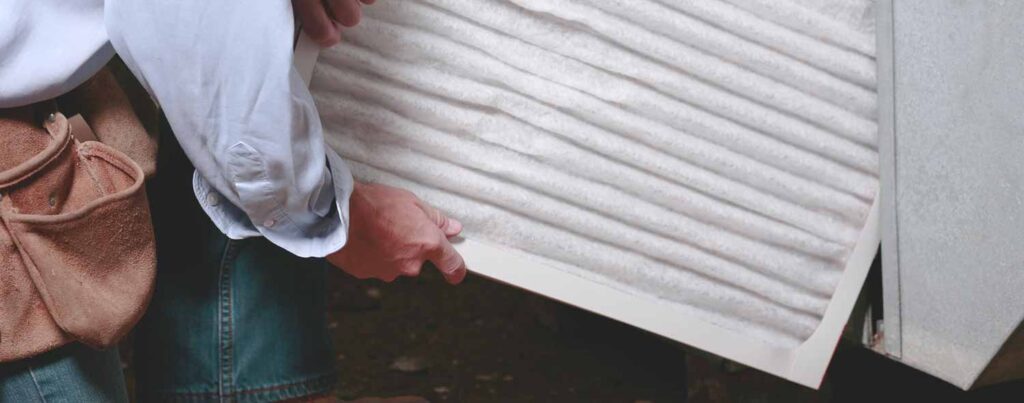How to Keep Pipes From Freezing
As a general rule, the “temperature alert threshold” for freezing pipes is about 20 degrees Fahrenheit. This temperature was determined by researchers at the Building Research Council at the University of Illinois, who determined that uninsulated water pipes began freezing when the temperatures outside dropped to 20 degrees or below.
However, this is not a hard-set rule. Depending on their exposure to wind and the elements, pipes can freeze when temperatures are higher than 20 degrees. In interior spaces, if pipes are near cracks or openings that let in cold air, they may develop ice blockages even if they are in a heated space.
To keep your pipes from freezing and bursting, make sure they are not exposed to temperatures approaching the alert threshold of 20 degrees.
What to Do If Your Pipes Freeze
If your pipes are frozen, you can take steps to reduce potential damage and help melt the ice blockages — but not every cold snap will mean frozen and blocked pipes. Look for these signs to check if your water system is truly frozen:
- Frosty pipes: If a section of your piping system is exposed, check to see if any frost has developed on the surface. If it has, there is a good chance your pipe is frozen.
- Unusual smells: Strange and odorous smells coming up from a drain or faucet could indicate a frozen pipe. If your pipes are blocked by ice, the smells have nowhere to escape except back in the direction of your home.
- No water: One of the most obvious signs that a pipe has frozen is a lack of running water. If you turn on a faucet and nothing or only a small trickle of water comes out, this probably indicates that the pipe has an ice block.
Once you’ve determined your pipes have frozen, you can take steps to thaw them out. However, take care when trying to unfreeze any pipes — if one of them has burst, thawing them out could cause a flood. For broken pipes, the best course of action is to turn off your water at the main shutoff valve and consult with an experienced plumber. They can resolve the problem before spring temperatures unfreeze the pipes and flood your home.
If your pipes aren’t ruptured, you can take the following steps to unfreeze them and restore running water to your home:
- First, turn on the faucet. As the ice plug in your pipe begins to melt, you want the water to be able to flow through the pipe. The running water will help melt the rest of the ice.
- Apply heat to the frozen portion of the pipe. If you can access the portion of pipe that has ice, you can begin thawing it by directly applying heat. Wrap an electric heating pad around the section of pipe, or use a portable space heater or an electric hair dryer.
- Keep applying heat until the full water pressure is restored. Check all other faucets in your home to see if any other pipes show signs of freezing — if one pipe has frozen, it’s likely that others have as well.
If you aren’t able to locate the frozen section of pipe, call a licensed plumber to help.

Precautions You Can Take To Prevent Your Water Pipes Bursting:
There are no practical ways of heating the ground temperature around your home, so stopping the contraction caused by the cold water is not something you can control. Our advice is to be mindful of your plumbing system as the temperatures change and check to see if you have any leaks. While we can’t stop the leaks caused by temperature drops, there are things you can do to prevent pipes from freezing and bursting. Here is a list of eight things that you can do to avoid water pipe bursts:
1. Keep Water Faucets Running
If it is extremely cold outside, always keep one or two faucets running slowly. Water moving through the system should prevent the line from freezing.
2. Direct Warm Air To Cold Areas Of Your Home
Often, the pipes that freeze are located near an outside wall or a window, so be sure to direct warm air to any colder areas of your home. (Start in your basement and look for any pipes near the exterior of the home).
3. Leave Your Cabinet Doors Open
If your kitchen sink is on an outside wall (as it usually is), be sure to leave cabinet doors open to allow warm air into the cabinet. Your kitchen faucet is usually to leave on during extremely cold weather.
4. Disconnect Your Hose From The Outside Faucet
Be sure to disconnect your hose from the outside faucet. If you leave your hose connected, water is not able to drain out of your hose bib and will freeze and break the device.
5. Install Heat Tape
There is a product called heat tape that can be installed and will warm pipes as needed during cold weather. While you could do this yourself, you may want to consult with an Indianapolis plumber to learn some best practices.
6. Seal Leaks That Allow Cold Air Into Your Home
Seal leaks that allow cold air into your home where pipes are located. Look for air leaks around electrical wiring, dryer vents, and pipes. Use caulk or insulation to keep the cold out. With severe cold, even a tiny opening can let in enough cold air to cause a pipe to freeze.
7. Check Your Home’s Temperature
Prevent temperatures from dropping below 32 degrees in any area of your home where water lines are located.
Not Just for Cold Climates
It is a common misconception that frozen pipes are an issue only for homes in typically cold climates. However, the homes that are actually more vulnerable to frozen pipes are those in typically warmer climates because the pipes may not be properly insulated against frigid temperatures, or they may be located in unprotected areas (or even outdoors). Abnormally cold weather puts these pipes at risk.
Wherever you live, you need to worry only about the water supply pipes, not the drain pipes. Water pipes are small, only about 1 inch in diameter or smaller. Drain pipes are 1 1/2 inches and larger and are usually made of plastic. Drain pipes carry waste water, but they do not hold water and are not pressurized like water pipes, so freezing inside drains is not a concern.
Adjust your habits
One common scenario in which pipes freeze is when people go on vacation and turn off the heat, which causes the temperature inside the house to drop significantly. Thus, “in an unoccupied house we recommend keeping your home above at least 60 degrees,” Mccan says.
Other rules to follow:
- Keep interior doors open (this allows the heat to circulate throughout your home more efficiently).
- If you have ceiling fans, “flip the switch in reverse to draw the air down and warm the room,” Mccan says.
- Keep garage doors shut, especially if there are water lines in the garage (which tends be colder than other areas of the house).
- Close outdoor vents, such as in attics or crawlspaces, to prevent cold exterior air from penetrating your home.
- Disconnect all outside water hoses and let cold water trickle out of faucets in unheated areas or where pipes run on an exterior wall, as this can help relieve any pressure building from ice inside a pipe.
Install water alarms
Like smoke detectors, water sensors can be a godsend during an emergency. These devices detect leaks before costly water damage occurs, which can save you hundreds if not thousands of dollars in repairs. They can also detect moisture before mold can grow. Mccan advises placing water alarms strategically throughout your home in areas that are at risk of water damage — under sinks, behind toilets, near water heaters, refrigerators or dishwashers, next to washing machines, and close to air conditioner drain tubes.

Protect Your Pipes:
We all know water expands as it freezes. If water inside your pipes freezes, it will expand, too, which can cause your pipes to crack and burst. Pipes also can burst when pressure builds up behind a chunk of ice, which is why it’s a good idea to leave faucets dripping in very cold weather. Either way, a burst pipe can cause massive damage. Take a few steps to winterize your pipes and avoid a potentially catastrophic claim
- Drain water from outdoor faucets and sprinkler systems to keep those pipes from freezing.
- Disconnect and store outdoor hoses; cover outdoor faucets with foam insulators.
- Protect water pipes that run through unheated areas of your home with insulation, such as the attic, basement, or garage.
Pro Tip: Know where your water shutoff valve is so that you can turn off the water in case of an emergency. Typically it’s located in the basement or buried near the road.
Check the Heat:
The time to be sure you’re going to stay warm all winter is before the weather gets too cold. Check your furnace by turning on the heat and the blower to be sure they’re operating as they should.
- Change your furnace filter at the start of the season and then every two to four months. Filters get dirty much more quickly if your home is dusty or if you have furry or feathery pets. Clogged or dirty filters are less efficient, which means your home might not warm up properly.
- Consider installing a programmable thermostat if you don’t have one. Programming it to be cooler at night and when you’re not at home will save you money, and you can program it to be warmer for when you return or get up on cold winter mornings.
Pro Tip: Reverse the direction of your ceiling fans. Everybody thinks of using fans in the summer, but they can help you stay warm in winter too. Set the blades to turn clockwise to circulate warm air from the ceiling down into the room.